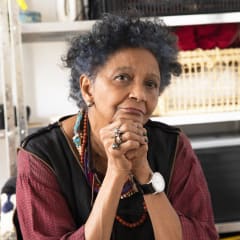...vivem no compasso do sol Sonia Gomes
Mendes Wood DM is pleased to unveil the first solo exhibition by Sonia Gomes in Paris. Titled ...vivem no compasso do sol*¹ , the show features new works from Gomes’s vast production, including floor, hanging, and wall textile-based sculptures, as well as bronzes, collages, and drawings. An essay by art historian Anne Lafont accompanies the presentation.*²
Cocoon and ligatures: Sonia Gomes between the threads
A whole world opens up to us when we enter the work of Sonia Gomes, a world that contains all the possible avatars of textile: from fine threads to sturdy ropes, replaced occasionally by cables, including scraps of embroidered textiles, printed silks, batiks and other fabrics, interwoven to form surfaces, structures, masses of decorated fibres, or little antennaed monsters that concede nothing to anthropomorphism (Trouxa). The atmosphere is organic in the textures and volume, as fabric envelopes are stuffed and sewn, patched or ‘rapaillées’, as the Québécois poet Gaston Miron wrote in 1970, resorting to the popular language that was seeking a term to describe ‘gathering scattered objects’. Thus, Sonia Gomes ‘rapaille’ the fabrics given to her; she arranges them and gives them life and meaning through enhanced thickness and texture or replayed graphic motifs. At times, they form filamentous magmas evoking Spanish moss dangling from trees in the tropical American regions (Pendente). But this is metaphorical, since the material proudly asserts human labour, the labour of art. The twisting of masses, the stretching of fabrics, or the raised stitching, all produced by the artist’s hand, underlie the work in a rough and meaningful way.
The omnipresent hand of Sonia Gomes is powerful in these configurations of fibres, colored almost to the point of orgy. Nowhere is intention divorced from form. The aesthetic experience comes from the pressure endured by the stuffing, constrained both by ties and ornamented fabric casings. These sophisticated meanders – more often original than painted or drawn by the artist – are somehow quoted in Sonia Gomes’s work. The artist appropriates embroidery, lace, prints as signs of fellow working hands, of small manufacturing workshops summoned and honoured by an artist who embraces the world, a world of female makers and users, perhaps also of feminine garments.
In the work of Sonia Gomes, the act of quoting is not just a postmodern gesture – though it undeniably intersects with it – rather, it embodies the quintessentially Black artistic gesture of repairing the world through salvaging and reshaping. Attention is given to what is – the previous life of the fabric – and to what could be, through the utopian reclaiming of a piece of cloth, a doily, a curtain scrap, or even a burlap sack. Fibre can have several lives, which the artist delights in kneading, stuffing, and piercing as propositions to transform and share what’s already there, rather than excessively clutter up the earth and art. Material and manual, feminine and Black, the art of Sonia Gomes departs from the traditional African-American art of quilting, which was also about patching, to embrace the model of the living, the forms of the living, in what I believe to be: the emulation of the silkworm’s activity.
For it is decidedly this horizon, simultaneously animal and vegetal, that emerges from Sonia Gomes’s work when she persists in creating these constrained figures which reveal themselves in their desire to transform into butterflies (the wing patterns are there, suggested through prints or embroidery); but the constricting ligatures prevent the insect from flying and spreading its wings. The fibre cocoon is bound up and this being in becoming, with its round, bulging – but hindered – shapes, is a way, as refined as it is violent, to give shape to the intensity of a life stuck to the foetal state, at the possible state. Therefore, as Sonia Gomes puts it, her yellow is indeed her gold (Meu amarelo é ouro), she who chooses the modesty of scraps over the panache of fabric unfolded in its entirety. Waste can become art with Sonia Gomes, who draws us into her intense, inextricable world of density and yoke.
— Anne Lafont
*¹ The title of the show was borrowed from an essay by curator and researcher Yina Jiménez Suriel included in Sonia Gomes's upcoming monograph.
*² Anne Lafont is an art historian, professor, and research director at the School of Advanced Studies in Social Sciences (EHESS) in Paris.


